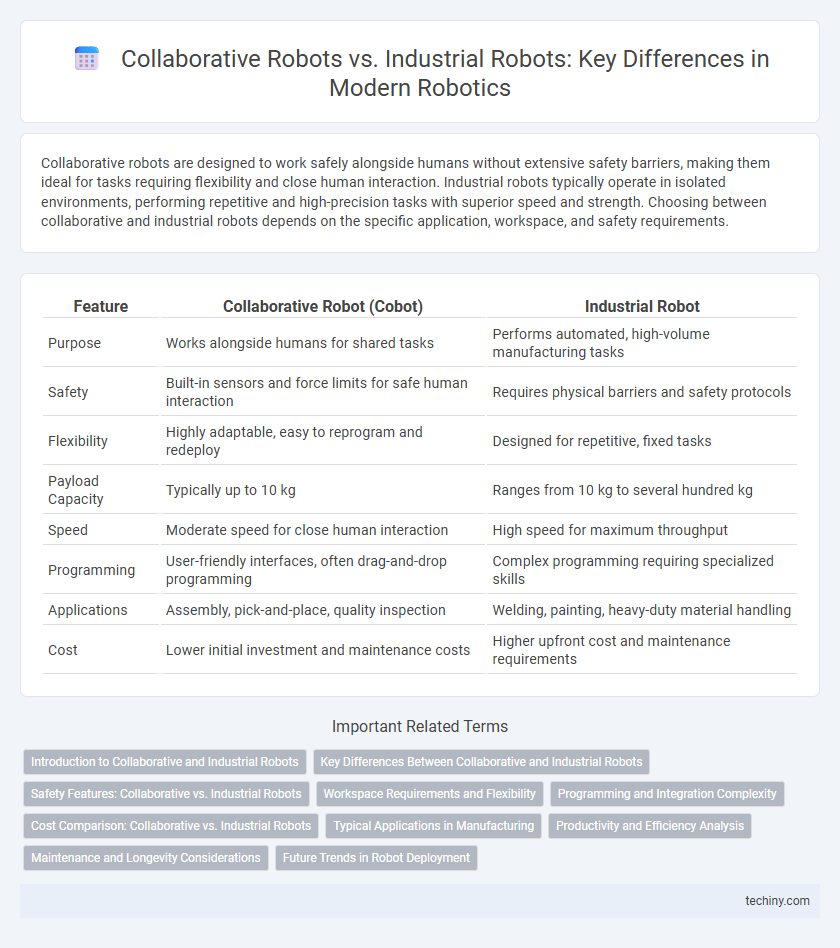Collaborative robots are designed to work safely alongside humans without extensive safety barriers, making them ideal for tasks requiring flexibility and close human interaction. Industrial robots typically operate in isolated environments, performing repetitive and high-precision tasks with superior speed and strength. Choosing between collaborative and industrial robots depends on the specific application, workspace, and safety requirements.
Table of Comparison
| Feature | Collaborative Robot (Cobot) | Industrial Robot |
|---|---|---|
| Purpose | Works alongside humans for shared tasks | Performs automated, high-volume manufacturing tasks |
| Safety | Built-in sensors and force limits for safe human interaction | Requires physical barriers and safety protocols |
| Flexibility | Highly adaptable, easy to reprogram and redeploy | Designed for repetitive, fixed tasks |
| Payload Capacity | Typically up to 10 kg | Ranges from 10 kg to several hundred kg |
| Speed | Moderate speed for close human interaction | High speed for maximum throughput |
| Programming | User-friendly interfaces, often drag-and-drop programming | Complex programming requiring specialized skills |
| Applications | Assembly, pick-and-place, quality inspection | Welding, painting, heavy-duty material handling |
| Cost | Lower initial investment and maintenance costs | Higher upfront cost and maintenance requirements |
Introduction to Collaborative and Industrial Robots
Collaborative robots, or cobots, are designed to work alongside humans safely without extensive safety guarding, featuring sensors and advanced algorithms to detect human presence and avoid collisions. Industrial robots operate autonomously or via pre-programmed instructions in isolated environments, excelling in repetitive, high-precision tasks such as welding, assembly, and material handling. The integration of cobots enhances flexibility and human-robot interaction in manufacturing, whereas industrial robots provide high-speed, heavy-duty automation for mass production.
Key Differences Between Collaborative and Industrial Robots
Collaborative robots (cobots) are designed for direct interaction with human operators, featuring advanced sensors and safety mechanisms to enable shared workspaces without extensive safety barriers. Industrial robots typically operate autonomously in isolated environments, offering high speed, precision, and payload capacity for repetitive, heavy-duty tasks. Cobots prioritize flexibility, ease of programming, and adaptability, whereas industrial robots emphasize maximum throughput and robustness for large-scale manufacturing processes.
Safety Features: Collaborative vs. Industrial Robots
Collaborative robots (cobots) are equipped with advanced safety features such as force sensors, speed limits, and emergency stop mechanisms that allow safe interaction with human workers without extensive safety barriers. In contrast, industrial robots typically require physical safety cages, light curtains, or pressure-sensitive mats to prevent human injury due to their higher speeds and stronger forces. The integration of real-time monitoring systems in collaborative robots further enhances safety by enabling immediate response to unexpected human presence within the robot's operational zone.
Workspace Requirements and Flexibility
Collaborative robots (cobots) require significantly less workspace due to their compact design and ability to safely operate alongside human workers without extensive safety barriers. Industrial robots typically demand larger, dedicated work cells with safety fencing to isolate them from personnel, limiting floor space efficiency. Cobots offer enhanced flexibility by easily adapting to varied tasks and dynamic production environments, whereas industrial robots excel in high-volume, repetitive operations but lack quick redeployment capabilities.
Programming and Integration Complexity
Collaborative robots often feature user-friendly programming interfaces with drag-and-drop functionalities and require minimal coding skills, significantly reducing integration complexity compared to traditional industrial robots. Industrial robots typically demand advanced programming expertise, custom coding, and extensive fixture setup, increasing deployment time and costs. Seamless integration of collaborative robots in shared workspaces enhances flexibility, whereas industrial robot systems necessitate rigid safety barriers and dedicated programming environments.
Cost Comparison: Collaborative vs. Industrial Robots
Collaborative robots typically cost between $35,000 and $60,000, offering a lower initial investment compared to traditional industrial robots, which range from $100,000 to $150,000 or more depending on payload and complexity. The total cost of ownership for collaborative robots is often reduced due to lower programming requirements and enhanced safety features that eliminate the need for expensive safety cages. Industrial robots incur higher installation and maintenance costs, but their faster cycle times and greater payload capacities can justify the higher upfront expense in high-volume manufacturing environments.
Typical Applications in Manufacturing
Collaborative robots excel in light assembly, quality inspection, and packaging tasks where human-robot interaction enhances flexibility and efficiency. Industrial robots dominate heavy-duty operations such as welding, painting, and material handling, providing high precision and speed in repetitive manufacturing processes. Integration of collaborative robots enables safer, adaptable workflows, while industrial robots drive productivity in large-scale, high-volume production environments.
Productivity and Efficiency Analysis
Collaborative robots (cobots) enhance productivity by working safely alongside humans, enabling flexible task allocation and reducing downtime associated with reprogramming. Industrial robots deliver higher speed and precision, boosting efficiency in repetitive, high-volume tasks but require safety barriers and specialized programming. Balancing the adaptability of cobots with the power of industrial robots can optimize overall production efficiency in manufacturing environments.
Maintenance and Longevity Considerations
Collaborative robots (cobots) require less frequent maintenance due to their lightweight design and integrated safety features, which reduce mechanical stress and wear. Industrial robots, built for high-speed, heavy-duty tasks, demand regular, intensive maintenance to ensure reliability and prevent costly downtime. The longevity of industrial robots typically exceeds that of cobots, thanks to robust construction and specialized components designed for continuous operation in harsh environments.
Future Trends in Robot Deployment
Future trends in robot deployment emphasize the increasing integration of collaborative robots (cobots) alongside traditional industrial robots to enhance flexibility and efficiency in manufacturing. Cobots are expected to evolve with advanced sensors and AI, enabling safe human-robot interaction without physical barriers, while industrial robots will continue to advance in speed and precision for high-volume tasks. This hybrid deployment drives smart factory innovations and supports Industry 4.0 goals by combining automation scalability with dynamic human collaboration.
collaborative robot vs industrial robot Infographic

 techiny.com
techiny.com